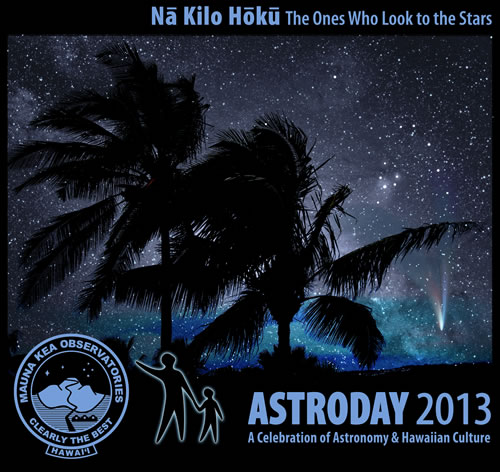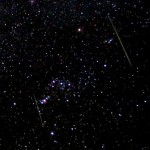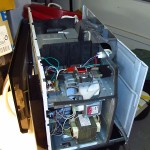Tomorrow is AstroDay at the Prince Kuhio Plaza in Hilo. I will be there! Will you?

When you want to see the stars, find someplace dark
Tomorrow is AstroDay at the Prince Kuhio Plaza in Hilo. I will be there! Will you?


For viewers here in the Hawaiian islands this will be a deep partial solar eclipse, with well over 40% of the Sun obscured by the Moon. This is enough to produce a noticeable drop in the Sun’s brightness at mid-day.
Please exercise caution when viewing the Sun! Use appropriate eye protection or indirect observing techniques to project an image of the Sun. The link at the start of this paragraph leads to a great discussion on viewing the Sun safely. As always the single best source on the web (or anywhere) for eclipse and transit information is Fred Espenak’s eclipse website at NASA. Stop by whenever you have a question on upcoming events as well as viewing and photography tips.
| Location | Begins | Maximum | Ends | Altitude | Azimuth | Magnitude |
| Honolulu | 14:23 | 15:48 | 17:01 | 43 | 275 | 44 |
| Hilo | 14:31 | 15:56 | 17:05 | 61 | 270 | 47 |
The early hours of dawn on May 5th will see the peak of the ηAquariid meteor shower. This is a reliable shower that produces anywhere from 30-80 meteors each hour near peak. Resulting from debris left behind by Comet 1P/Halley this shower approaches the Earth from the direction of the constellation Aquarius. As this constellation is quite low in the sky during the shower the meteors are entering the atmosphere at a low angle, this often results in meteors with long trains crossing much of the sky. A good shower that produces great fireballs.

IMO analyses in recent years, based on data collected between 1984–2001, have shown that ZHRs are generally above 30 between about May 3–10, and that the peak rates appear to be variable on a roughly 12-year timescale. Assuming this Jupiter-influenced cycle is borne-out, the next trough is due around 2014–2016, so ZHRs should be relatively modest in 2013, according to this idea – IMO website
The ηAquariid shower has a broad peak with several weeks of activity either side of the peak. The entire meteor shower lasts from around April 19 to May 28. Any morning from May 3rd to May 10th can be worth watching with rates to around 30 meteors per hour. The peak itself is predicted for 01:00UT on May 6th (15:00HST May 5th), but this shower often produces subpeaks as the Earth passes through clouds of debris left on successive orbits of Halley’s Comet.
The radiant for the ηAquariid shower does not rise until the last few hours of dark, about 2:30am, making this an early morning observing exercise. 2013 does offer decent viewing conditions, with only a slim waning Moon on the day of peak activity and new Moon occurring a few days later on the 10th. Remember, meteor watching can be enjoyed without any special equipment, just a dark sky and a safe place to watch from. Perhaps a good reason to get out under a dark sky? But then, should you ever need a reason to go observing, just go.
Eventually it will break.
This is the rule for household appliances. I would just prefer that it not be a two year old microwave that I had installed into the kitchen cabinetry. Yes, I can probably fix it… after I dismount it and lower it out of place. A task much easier typed than done. No matter, I am on-call this weekend. I will be around the house all day anyway, may as well get something productive done.
An over-the-stove microwave costs a few hundred dollars, too much to just run out and buy a new one. Not enough to justify a repair call. I do not even want to think of what it would cost to get a repairman out to the house. Driving from Kona? Hawaiian rates? I can think of few easier ways to get robbed.

Astronomy is a science where human timescales become insignificant. It seems like everything we are watching takes millions or even billions of years to occur. To be sure, there are a few things that happen quickly, like supernovae, but those events are the exceptions. Everywhere we look we see the stately dance of stars and galaxies, the formation of worlds. The dance is spread across distances and times so vast that even those who study the universe have difficulty comprehending the sheer immensity involved. Stars and planets take hundreds of thousands of years to form, a galaxy collision may go on for millions of years.

Today the planet Saturn will pass through opposition, directly opposite the Sun in our sky. The planet will be well placed for observation all night long, rising at sunset, transiting at midnight, and setting at sunrise.
During opposition the planet and rings will be slightly brighter than normal, an effect known as the opposition effect. The effect is most notable in the rings where the apparent brightness can increase by 30%. The effect is a combination of two factors, shadow hiding and the retro-reflective properties of the ring particles.
Mercury is sliding into the light of dawn this week. Currently about 10° elevation at sunrise, the planet will disappear into the Sun’s glare over the next few days. It will pass through superior conjunction on May 11th, to reappear for an evening apparition around May 20th.